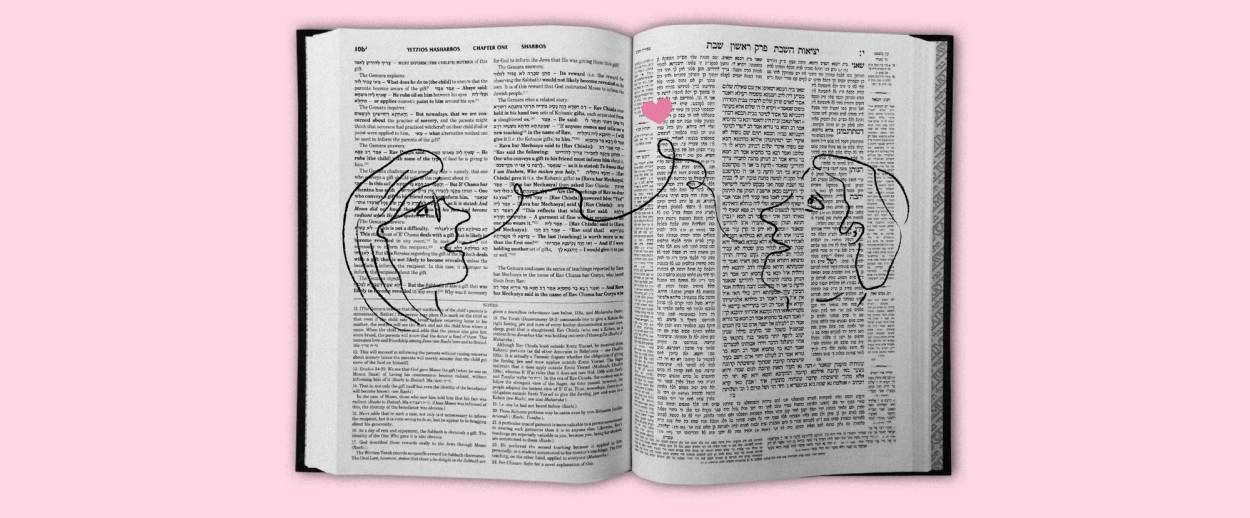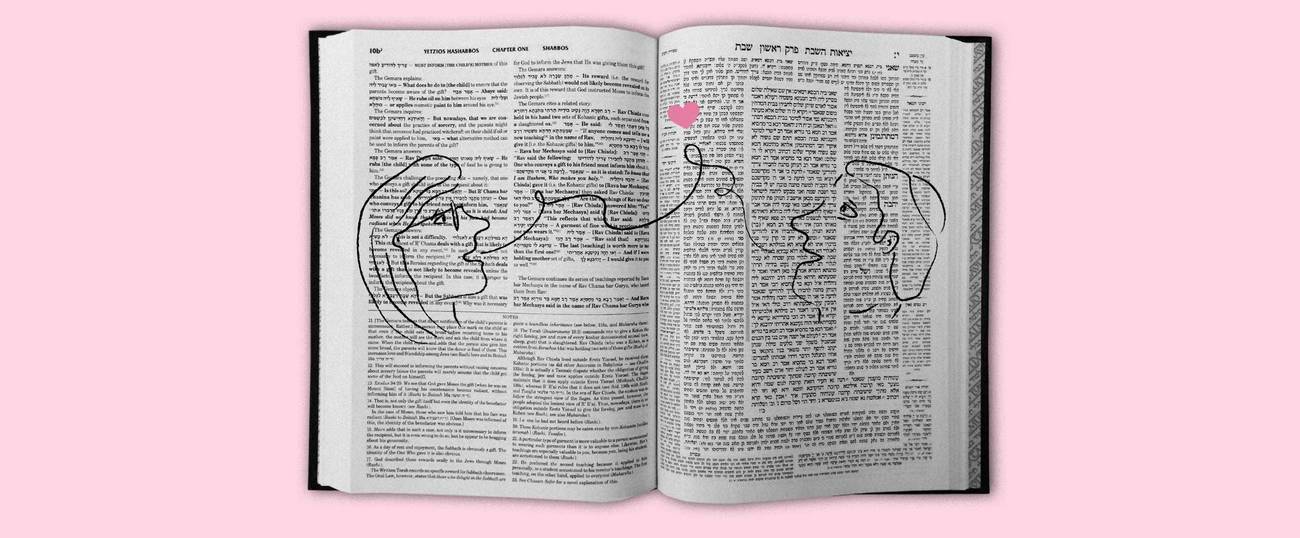The Language of Our Love
Measuring a relationship in poems and tractates of Talmud




It seems like everyone is forever extolling the value of a weekly “date night” for married couples, but my husband and I never quite manage to make it work. Our three preschoolers can’t fall asleep without us, and the baby still wakes up in the middle of the night crying for her mother’s milk. Neither of us has jobs that we can set aside in the evenings: Daniel teaches literature at a university and I am a translator and editor, so there are always more pages to read and papers to grade. Most nights we sit at the long desk we share, occasionally reading excerpts aloud to one another or chuckling over a particularly awkward turn of phrase. We usually send emails rather than interrupting each other’s thoughts, which may seem strange since we are just a few feet apart. But it’s not all that surprising given how bound up in the written word our relationship has always been.
At the outset, ours was an epistolary romance, though we lived in the same Jerusalem neighborhood. We were both expatriates, born and raised on opposite sides of the Hudson, but we’d met each other only after each of us had traveled halfway around the world. In spite of our proximity, we communicated almost exclusively by email because I was painfully protective of my privacy and didn’t want anyone we knew to see us together until our relationship was on more-solid ground. Daniel would email me selections from the poems he was analyzing in his Ph.D. dissertation, and I’d write back analyzing his analyses until we had taken each poem thoroughly apart. Only when he grew so bold as to send me Byron’s “She Walks in Beauty” did I refrain from comment, afraid of being too explicit about what was, in fact, unfolding between us—“the smiles that win, the tints that glow.”
Throughout our relationship, I was generally the reserved one—the one who read over her emails again and again before pressing “send.” This was the case even though few of the words I’d write him were my own. We communicated mainly by quoting poetry to one another. “What are you doing this evening?” Daniel would ask me. I did not write back that I was getting a haircut. Instead, I sent him back a line from Yeats: “To be born a woman is to know, although they do not talk of it at school, that we must labor to be beautiful.” My allusion to “Adam’s Curse” didn’t elude him, and minutes later I got an email back from him paraphrasing that same poem: “I’ll be reworking my conference paper while you’re primping. Ugh. All this stitching and unstitching is probably for naught.” And I smiled to myself, and wrote back, “You’re probably right. Better to just go down upon your marrow-bones and scrub your kitchen floor instead.” I knew his floor was impeccably clean—he took much better care of his apartment than I did of mine—but I couldn’t resist another reference to the poem. And so we would go on and on, quoting from beautiful old books, until we grew quiet in the name of love.
Soon the range of our references expanded from poetry to Talmud. By the time I met Daniel, I’d already been studying Talmud for several years, and I was in the third year of my daf yomi cycle. Daf yomi is an international program to study the entire Babylonian Talmud—the main text of rabbinic Judaism—in seven-and-a-half years, at the rate of a page a day. Essentially daf yomi is the world’s largest book club, with tens of thousands of Jews—still mostly men—learning the same new page each day. Only recently have women begun to engage with these texts, which for 1,500 years were the province of the male half of the population. Through my study of daf yomi, I became intimately familiar with the world of the ancient rabbis living in the Galilee and Babylonia (now Iraq) during the first few centuries of the Common Era. The Talmud is an inherently dialogical text, unfolding as a series of conversations among the rabbis about everything from Sabbath observance to sacrifices to courtship, astrology, and demonology. As I made my way through it, I found myself caught up in the rabbinic conversation, and as Daniel and I grew closer, he became part of that conversation, too.
One night Daniel asked me if I wanted to go out with him to the light show, a summer festival in which the walls of the Old City of Jerusalem are lit up as if by magic lantern. I shook my head.
“Why can’t we ever go out? I mean, really go out?” Daniel asked. “You can’t always be such a recluse.”
“I’m not a recluse,” I responded. “I just believe in hezek re’iya.” This term, which comes up in Bava Batra—the volume of Talmud we were learning at the time—literally means “the damage of seeing.” According to this notion, gazing into another person’s private space is tantamount to physical damage. I believed it. I thought of our relationship as a fragile butterfly that I wished to keep cupped in my hands. I worried that the harsh light of other people’s gazes might damage or still its dazzling wings, and I was terrified of suddenly being deprived of all the beauty that had blessedly flown into my life.
The Jerusalem we inhabit is less a city than a small village of overlapping social circles. I was not ready for all our friends to find out that we were dating. I’d been married and divorced a few years earlier, and after the devastation of that failed relationship, I could not bear to fail publicly again. I suspect the Talmudic rabbis would have understood. In a discussion about the importance of storing one’s money in a safe and secure place, Rabbi Yitzhak comments in Bava Batra, “Blessing is only to be found in that which is hidden from the eye.”
Our courtship lasted eight months, a period I remember most by the Talmud we were studying. Like T.S. Eliot’s Prufrock, who measured out his life in coffee spoons, I have measured out the last decade of my life in tractates, as volumes of Talmud are known. I remember episodes in my life by what I was studying at the time. Daniel proposed to me—not incidentally—on the day we read the rabbis’ discussion in the eighth chapter of Bava Batra about the 15th of Av, a day on the Jewish calendar when women would dress in white and go out into the fields to seek their prospective husbands. Our wedding did not take place in a field, but I carried that image with me.
It would have been impossible, given the norms of our Jewish community, not to have had a wedding ceremony for all our friends and family. But such a public avowal of our love seemed antithetical to my Dickensonian sensibilities, and I would have been much happier to elope and spend a few years making sure it was really going to work out.
Daniel was exceedingly tolerant of my pre-wedding jitters, even when I pulled him aside just moments before the ceremony began. By that point the band was already playing, and I could hear the violins humming the strains of a lyrical song about two lovers who head out at dusk to an orchard redolent of myrrh and incense. It was a song I had chosen myself, but now I was too panicked to enjoy it. “How can you know our marriage will last?” I asked Daniel. “How can you know what the future holds?”
“Granted, I’m no prophet,” Daniel conceded, and already I could see the gleam in his eye—he had thought of an allusive rejoinder. “But you’re a scholar of Talmud, and a scholar is preferable to a prophet,” he quoted from Bava Batra. He knew that if anything would reassure me, it was a passage from the Talmud.
“Perhaps you’ll tire of me,” I pressed on, invoking a William Matthews poem we both loved. Daniel smiled at the reference and played along, assuring me that I was like a great city to him, or like a park that finds new ways to wear each flounce of light. “Soil doesn’t tire of rain,” he quoted back at me just moments before he walked down the aisle. He had the last word, and I could only follow him with my eyes until it came time for me, too, to make my way to the wedding canopy.
That was seven-and-a-half years ago. Daniel and I just celebrated our daf yomi anniversary: Now, on our second read through the Talmud, we just came to the daily page from the date of our wedding. We’ve been through a lot together—four children, 2,700 pages of Talmud, and perhaps just as many poems. With a house full of preschoolers, we’re both exceedingly tired, though we haven’t tired of each other. We don’t quote poetry and Talmud to each other nearly as often these days, but it remains the language in which we express our love. Ironically, I have no problem being seen with Daniel in public nowadays, but who has time to go out? Fortunately, neither of us seems to mind. Our desk is covered in books, and there are many more pages to turn together.
***
Like this article? Sign up for our Daily Digest to get Tablet Magazine’s new content in your inbox each morning.
Ilana Kurshan is the author of If All the Seas Were Ink.